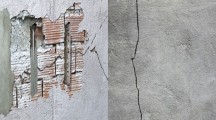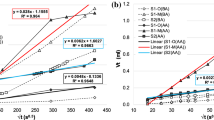Abstract
Thermal properties of insulating building mortars are dependent on those of their components.
Some properties of mortars change with age as well as on carbonatation phenomena. Carbonation develops only when moisture and carbon dioxide gas are present. The carbonation is due to the diffusion of carbon dioxide gas into the air in the pores; Fick’s laws are applicable in a first approximation.
In this study the thermal conductivity of the insulating mortars is determined as a function of ageing, moisture and components The thermal conductivity is measured in the conditions similar to these of utilisation.
In order to determine the variation of the thermal conductivity of insulating mortars as a function of humidity ratio, a series-parallel arrangement consisting of two layers is used. The thermal conductivity of the mortars is calculated. Values calculated in this way provided good correlations with test values for insulating mortars and a linear relation between the thermal conductivity and the initial dry density is obtained.
It is shown finally, that acting on the composition (nature of components, cement/lime ratio) it is possible to improve the quality of the mortars.
This study deals with the influence of ageing (carbonatation) moisture and composition on the thermal conductivity of an insulating mortar.
Access this chapter
Tax calculation will be finalised at checkout
Purchases are for personal use only
Preview
Unable to display preview. Download preview PDF.
Similar content being viewed by others
References
Tye, R.P. “Thermal conductivity” Academic Press, London and New York (1969)
Luikov A.V, “Heat and mass transfer in capillary porous bodies” Advance in heat transfer. Vol 1 (1964)
Philip J.P., De Vries D.A. “Moisture movement in porous bodies” Pergamon Press (1984)
Mourtada A. “Comportement thermique des mortiers dfisolation extérieure du bâtiment”. Thèse Docteur Ingénieur INSA Lyon (1982)
Eyraud M.N.C, Lareal P., et Gielly J. “Propriétés physicochimiques de l’eau dans les milieux poreux. Caractéristiques textu- rales des milieux poreux et facteurs susceptibles de les modifier”. Bull. Rilem. n°27 (1965)
Fauconnier R., Florence B., Laugier D., “Le transfert de l’humidité dans les matériaux isolants”. Promoclime Tome E n°3 (1979)
Krischer O., Kroll K. “Bases scientifiques de la technique dusèchage”. Traduction du Centre technique des industries aérauliques et thermiques.France.
Author information
Authors and Affiliations
Editor information
Editors and Affiliations
Rights and permissions
Copyright information
© 1985 Purdue Research Foundation
About this chapter
Cite this chapter
Mourtada, A., Bloch, A., Menguy, G., Laurent, M. (1985). Thermal Behaviour of Insulating Building Mortars: Experimental Apparatus, Carbonatation and Ageing. In: Ashworth, T., Smith, D.R. (eds) Thermal Conductivity 18. Springer, Boston, MA. https://doi.org/10.1007/978-1-4684-4916-7_41
Download citation
DOI: https://doi.org/10.1007/978-1-4684-4916-7_41
Publisher Name: Springer, Boston, MA
Print ISBN: 978-1-4684-4918-1
Online ISBN: 978-1-4684-4916-7
eBook Packages: Springer Book Archive




